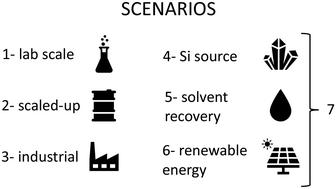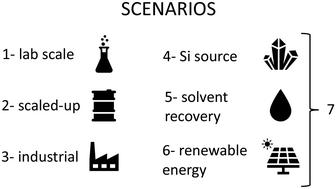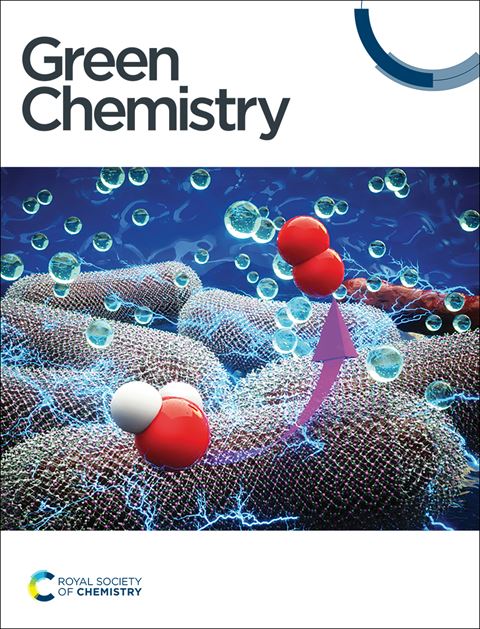小规模和大规模合成介孔二氧化硅材料的生命周期比较评估
IF 9.3
1区 化学
Q1 CHEMISTRY, MULTIDISCIPLINARY
引用次数: 0
摘要
二氧化硅介孔材料具有多种用途,一直受到科学界的广泛关注。然而,与制备这些材料相关的环境影响却鲜有研究。在本研究中,我们对 MCM-41、MCM-48、UVM-7、介孔 Stober 粒子、SBA-15、SBA-16、HMS、KIT-5、KIT-6、MSU、FDU、纳米 MCM-41 和纳米 MCM-48 等材料的小规模(克)和大规模(几公斤)生产应用了生命周期评估(LCA)方法。此外,还提出了各种改进措施,并对每种改进措施的影响进行了量化。结果表明,单一评分、损害类别的标准化和权重组合以及温室气体净排放量(NGHGE)的值在很大程度上取决于合成程序。就小规模而言,主要影响来自能源和溶剂的使用。相比之下,在大规模生产中,溶剂、四乙基正硅酸盐和结构引导剂的使用是主要的决定因素。根据对不同材料和方案得出的数值,我们估计在制备这类材料时,小规模和大规模生产每千克介孔材料的 NGHGE 分别为 54 ± 30 和 31 ± 18 千克二氧化碳当量。使用煅烧而非萃取、采用可再生能源以及蒸馏/精馏等措施都有助于显著减少对环境的影响。本文章由计算机程序翻译,如有差异,请以英文原文为准。


A comparative life cycle assessment of the synthesis of mesoporous silica materials on a small and a large scale†
Silica mesoporous materials have been the subject of wide scientific interest with various applications. However, the environmental impacts associated with their preparation have scarcely been studied. In the present work, we applied the Life Cycle Assessment (LCA) methodology to the materials MCM-41, MCM-48, UVM-7, mesoporous Stober particles, SBA-15, SBA-16, HMS, KIT-5, KIT-6, MSU, FDU, nano-MCM-41 and nano-MCM-48 for small- (grams) and large-scale (several kilograms) production. Furthermore, various improvements are proposed, and the impact associated with each of them is quantified. The results show that the values of a single score, a normalized and weighed combination of the damage categories, and net greenhouse gas emissions (NGHGE) are highly dependent on the synthesis procedures. On a small scale, the main impact is due to the use of energy and solvents. By contrast on a large scale, the use of solvents, tetraethylorthosilicate and the structure directing agent are the main determinants. From the values obtained for the different materials and scenarios, we estimate that the preparation of this class of materials could have an NGHGE of 54 ± 30 and 31 ± 18 kg CO2 eq. per kg of mesoporous material for small- and large-scale production, respectively. The use of calcination versus extraction, the incorporation of renewable energy and distillation/rectification are initiatives that can contribute to a significant reduction of the environmental impact.
求助全文
通过发布文献求助,成功后即可免费获取论文全文。
去求助
来源期刊

Green Chemistry
化学-化学综合
CiteScore
16.10
自引率
7.10%
发文量
677
审稿时长
1.4 months
期刊介绍:
Green Chemistry is a journal that provides a unique forum for the publication of innovative research on the development of alternative green and sustainable technologies. The scope of Green Chemistry is based on the definition proposed by Anastas and Warner (Green Chemistry: Theory and Practice, P T Anastas and J C Warner, Oxford University Press, Oxford, 1998), which defines green chemistry as the utilisation of a set of principles that reduces or eliminates the use or generation of hazardous substances in the design, manufacture and application of chemical products. Green Chemistry aims to reduce the environmental impact of the chemical enterprise by developing a technology base that is inherently non-toxic to living things and the environment. The journal welcomes submissions on all aspects of research relating to this endeavor and publishes original and significant cutting-edge research that is likely to be of wide general appeal. For a work to be published, it must present a significant advance in green chemistry, including a comparison with existing methods and a demonstration of advantages over those methods.
 求助内容:
求助内容: 应助结果提醒方式:
应助结果提醒方式:


